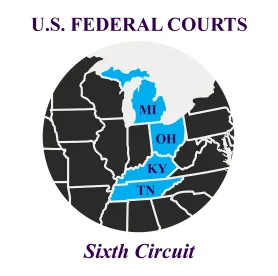We’ve previously discussed the procedural arguments for and against taking the case en banc that Judge Moore and Chief Judge Sutton (briefly) debated in their respective concurrence and dissent. As we noted in our earlier post, the Court split evenly on the en-banc issue, keeping these cases with the current three-judge panel. This post reviews Judge Sutton’s analysis (which was joined by seven other judges) of the merits issue at the center of all these cases: whether OSHA exceeded its authority in promulgating the ETS. Judge Sutton focuses his dissent on that issue, and it’s likely that his careful analysis will affect the panel’s review, and perhaps the Supreme Court’s likely review, of these cases going forward—whichever way they come out.
Judge Sutton argues that the clear-statement rule dooms OSHA’s ETS. Under that rule, Congress must clearly delegate to OSHA the authority to issue an ETS. He concludes that Congress did not clearly delegate that authority to OSHA in its enabling statue (the Occupational Safety and Health Act) or anywhere else. Judge Sutton traces the lineage of the clear statement rule to two constitutional principles articulated in Supreme Court precedent. The first principle is that Congress must “speak clearly if it wishes to assign to an agency decisions of vast economic and political significance.” Util. Air Regul. Grp. V. EPA, 573 U.S. 302, 324 (2014). The second is that Congress must “enact exceedingly clear language if it wishes to significantly alter the balance between federal and state power.” Ala. Ass’n of Realtors v. Dep’t of Health & Hum. Servs, 141 S. Ct. 2485, 2489 (2021). According to Judge Sutton, the clear statement rule must apply because OSHA’s ETS covers 80 million American workers and encroaches upon the States’ traditional police power.
Having found that the clear-statement rule applies here, Judge Sutton explains why he thinks Congress failed to supply that clear statement. Analyzing the Occupational Safety and Health Act, he concludes that it addresses “only occupational health and safety risks,” like “a chemical used to make a plastic product or the heat generated at a steel foundry.” It does not address “any risk facing the country and every citizen in it.” This is true, as well, for the Act’s narrow emergency-rulemaking exception. Judge Sutton reasons that the exception, like the Act’s other provisions, is directed only toward dangers arising out of work or work-related activities. He also emphasizes the unprecedented nature of the vaccinate-or-test mandate, which he believes to be strong evidence Congress did not clearly delegate to OSHA the authority to promulgate the ETS.
Judge Sutton also points to OSHA’s failure to explain why the ETS was “indispensable” or “essential,” which he reasons is necessary for an emergency-rulemaking exception. He also writes that any such explaining would likely fail considering all the other “less intrusive, more tailored” approaches the agency could have taken. Nor, in Judge Sutton’s view, was the ETS directed toward a true “emergency,” as neither masking nor vaccination requirements are entirely new options available to the government. He points out that the people with the most serious risk are generally not working and that risks faced by the vaccinated are far less serious (as OSHA concedes). Perhaps more importantly, he notes that the actual “emergency” at this point is that part of the population willingly chooses to remain unvaccinated, despite the proven benefits of the vaccine. In this respect, Judge Sutton also points out that vaccination is not “temporary.”
Having concluded that the challengers were likely to succeed on the merits, Judge Sutton quickly disposes of several of OSHA’s counterarguments, including that the Court must defer to OSHA under the doctrine of Chevron deference. He points out that applying Chevron deference would mean that the most significant questions raised by expansive exercises of regulatory power could be insulated from judicial review.
Because Judge Sutton and his fellow dissenters would strike down the ETS on statutory principles, his opinion avoids opining on constitutional issues potentially presented by the ETS (as argued by many of the petitioners), such as whether Congress could issue a vaccine-or-test mandate under the Commerce Clause in the first place. He also avoids addressing whether Congress has the power to delegate that authority to the Executive Branch. (In his brief separate dissent, Judge Bush opines that Congress does not in fact have those powers).
Agree or disagree with his analysis, Judge Sutton’s thoughtful en banc dissent has emerged as the perhaps the most powerful (and the most narrow) judicial opinion against OSHA’s ETS. We will see what effect this has, if any, on the panel’s opinion.





 />i
/>i

